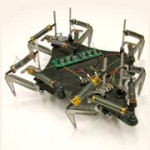Archive for 2007
Assessment of Motion of a Swing Leg and Gait Rehabilitation With a Gravity Balancing Exoskeleton
- Тип контента: Научная статья
- Номер документа: 338
- Название документа: Assessment of Motion of a Swing Leg and Gait Rehabilitation With a Gravity Balancing Exoskeleton
- Номер (DOI, IBSN, Патент): 10.1109/TNSRE.2007.903930
- Изобретатель/автор: Sangwan, V., Fattah, A., Banala, S.K., Agrawal, S.K.
- Правопреемник/учебное заведение: Univ. of Delaware, Newark
- Дата публикации документа: 2007-09-17
- Страна опубликовавшая документ: США
- Язык документа: Английский
- Наименование изделия: Не заполнено
- Источник: http://ieeexplore.ieee.org/search/freesrchabstract.jsp?tp=&a
- Вложения: Не заполнено
- Аналитик: Глаголева Елена
 The gravity balancing exoskeleton, designed at University of Delaware, Newark, consists of rigid links, joints and springs, which are adjustable to the geometry and inertia of the leg of a human subject wearing it. This passive exoskeleton does not use any motors but is designed to unload the human leg joints from the gravity load over its range-of-motion. The underlying principle of gravity balancing is to make the potential energy of the combined leg-machine system invariant with configuration of the leg. Additionally, parameters of the exoskeleton can be changed to achieve a prescribed level of gravity assistance, from 0% to 100%. The goal of the results reported in this paper is to provide preliminary quantitative assessment of the changes in kinematics and kinetics of the walking gait when a human subject wears such an exoskeleton. The data on kinematics and kinetics were collected on four healthy and three stroke patients who wore this exoskeleton. These data were computed from the joint encoders and interface torque sensors mounted on the exoskeleton. This exoskeleton was also recently used for a six-week training of a chronic stroke patient, where the gravity assistance was progressively reduced from 100% to 0%. The results show a significant improvement in gait of the stroke patient in terms of range-of-motion of the hip and knee, weight bearing on the hemiparetic leg, and speed of walking. Currently, training studies are underway to assess the long-term effects of such a device on gait rehabilitation of hemiparetic stroke patients.
The gravity balancing exoskeleton, designed at University of Delaware, Newark, consists of rigid links, joints and springs, which are adjustable to the geometry and inertia of the leg of a human subject wearing it. This passive exoskeleton does not use any motors but is designed to unload the human leg joints from the gravity load over its range-of-motion. The underlying principle of gravity balancing is to make the potential energy of the combined leg-machine system invariant with configuration of the leg. Additionally, parameters of the exoskeleton can be changed to achieve a prescribed level of gravity assistance, from 0% to 100%. The goal of the results reported in this paper is to provide preliminary quantitative assessment of the changes in kinematics and kinetics of the walking gait when a human subject wears such an exoskeleton. The data on kinematics and kinetics were collected on four healthy and three stroke patients who wore this exoskeleton. These data were computed from the joint encoders and interface torque sensors mounted on the exoskeleton. This exoskeleton was also recently used for a six-week training of a chronic stroke patient, where the gravity assistance was progressively reduced from 100% to 0%. The results show a significant improvement in gait of the stroke patient in terms of range-of-motion of the hip and knee, weight bearing on the hemiparetic leg, and speed of walking. Currently, training studies are underway to assess the long-term effects of such a device on gait rehabilitation of hemiparetic stroke patients.
Категория: Научные статьи | Нет комментариев »
Design and Evaluation of the LOPES Exoskeleton Robot for Interactive Gait Rehabilitation
- Тип контента: Научная статья
- Номер документа: 734
- Название документа: Design and Evaluation of the LOPES Exoskeleton Robot for Interactive Gait Rehabilitation
- Номер (DOI, IBSN, Патент): 10.1109/TNSRE.2007.903919
- Изобретатель/автор: Veneman, J.F., van der Kooij, H., Van Asseldonk, E.H.F., Kruidhof, R., Hekman, E.E.G., Ekkelenkamp, R.
- Правопреемник/учебное заведение: Univ. of Twente, Enschede
- Дата публикации документа: 2007-09-17
- Страна опубликовавшая документ: Нидерланды (Голландия)
- Язык документа: Английский
- Наименование изделия: Не заполнено
- Источник: http://ieeexplore.ieee.org/search/freesrchabstract.jsp?tp=&a
- Вложения: Да
- Аналитик: Дмитрий Соловьев
 This paper introduces a newly developed gait rehabilitation device. The device, called LOPES, combines a freely translatable and 2-D-actuated pelvis segment with a leg exoskeleton containing three actuated rotational joints: two at the hip and one at the knee. The joints are impedance controlled to allow bidirectional mechanical interaction between the robot and the training subject. Evaluation measurements show that the device allows both a «patient-in-charge» and «robot-in-charge» mode, in which the robot is controlled either to follow or to guide a patient, respectively. Electromyography (EMG) measurements (one subject) on eight important leg muscles, show that free walking in the device strongly resembles free treadmill walking; an indication that the device can offer task-specific gait training. The possibilities and limitations to using the device as gait measurement tool are also shown at the moment position measurements are not accurate enough for inverse-dynamical gait analysis.
This paper introduces a newly developed gait rehabilitation device. The device, called LOPES, combines a freely translatable and 2-D-actuated pelvis segment with a leg exoskeleton containing three actuated rotational joints: two at the hip and one at the knee. The joints are impedance controlled to allow bidirectional mechanical interaction between the robot and the training subject. Evaluation measurements show that the device allows both a «patient-in-charge» and «robot-in-charge» mode, in which the robot is controlled either to follow or to guide a patient, respectively. Electromyography (EMG) measurements (one subject) on eight important leg muscles, show that free walking in the device strongly resembles free treadmill walking; an indication that the device can offer task-specific gait training. The possibilities and limitations to using the device as gait measurement tool are also shown at the moment position measurements are not accurate enough for inverse-dynamical gait analysis.
Категория: Научные статьи | Нет комментариев »
Design and Validation of a Rehabilitation Robotic Exoskeleton for Tremor Assessment and Suppression
- Тип контента: Научная статья
- Номер документа: 908
- Название документа: Design and Validation of a Rehabilitation Robotic Exoskeleton for Tremor Assessment and Suppression
- Номер (DOI, IBSN, Патент): : 10.1109/TNSRE.2007.903917
- Изобретатель/автор: Ruiz, A.F., Rocon, E., Pons, J.L., Moreno, J.C., Belda-Lois, J.M.
- Правопреемник/учебное заведение: Consejo Superior de Investigaciones Cientificas, Madrid
- Дата публикации документа: 2007-09-17
- Страна опубликовавшая документ: Испания
- Язык документа: Английский
- Наименование изделия: Не заполнено
- Источник: http://ieeexplore.ieee.org/search/freesrchabstract.jsp?tp=&a
- Вложения: Да
- Аналитик: Дмитрий Соловьев
 Exoskeletons are mechatronic systems worn by a person in such a way that the physical interface permits a direct transfer of mechanical power and exchange of information. Upper limb robotic exoskeletons may be helpful for people with disabilities and/or limb weakness or injury. Tremor is the most common movement disorder in neurological practice. In addition to medication, rehabilitation programs, and deep brain stimulation, biomechanical loading has appeared as a potential tremor suppression alternative. This paper introduces the robotic exoskeleton called WOTAS (wearable orthosis for tremor assessment and suppression) that provides a means of testing and validating nongrounded control strategies for orthotic tremor suppression. This paper describes in detail the general concept for WOTAS, outlining the special features of the design and selection of system components. Two control strategies developed for tremor suppression with exoskeletons are described. These two strategies are based on biomechanical loading and notch Altering the tremor through the application of internal forces. Results from experiments using these two strategies on patients with tremor are summarized. Finally, results from clinical trials are presented, which indicate the feasibility of ambulatory mechanical suppression of tremor.
Exoskeletons are mechatronic systems worn by a person in such a way that the physical interface permits a direct transfer of mechanical power and exchange of information. Upper limb robotic exoskeletons may be helpful for people with disabilities and/or limb weakness or injury. Tremor is the most common movement disorder in neurological practice. In addition to medication, rehabilitation programs, and deep brain stimulation, biomechanical loading has appeared as a potential tremor suppression alternative. This paper introduces the robotic exoskeleton called WOTAS (wearable orthosis for tremor assessment and suppression) that provides a means of testing and validating nongrounded control strategies for orthotic tremor suppression. This paper describes in detail the general concept for WOTAS, outlining the special features of the design and selection of system components. Two control strategies developed for tremor suppression with exoskeletons are described. These two strategies are based on biomechanical loading and notch Altering the tremor through the application of internal forces. Results from experiments using these two strategies on patients with tremor are summarized. Finally, results from clinical trials are presented, which indicate the feasibility of ambulatory mechanical suppression of tremor.
Категория: Научные статьи | Нет комментариев »
Positive Feedback in Powered Exoskeletons: Improved Metabolic Eficciency at the Cost of Reduced Stability?
- Тип контента: Научная статья
- Номер документа: 7539
- Название документа: Positive Feedback in Powered Exoskeletons: Improved Metabolic Eficciency at the Cost of Reduced Stability?
- Номер (DOI, IBSN, Патент): Не заполнено
- Изобретатель/автор: James A. Norris, Anthony P. Marsh, Kevin P. Granata, Shane D. Ross
- Правопреемник/учебное заведение: School of Biomedical Engineering & Sciences Winston-Salem, Wake Forest University, Virginia Tech
- Дата публикации документа: 2007-09-07
- Страна опубликовавшая документ: США
- Язык документа: Английский
- Наименование изделия: Не заполнено
- Источник: Proceedings of the ASME 2007 International Design Engineerin
- Вложения: Да
- Аналитик: Глаголева Елена
 A broad objective of many lower extremity exoskeletons is to allow the wearer to expend less of their own energy for locomotion. Existing exoskeleton control algorithms are based on positive feedback. Forces are generated to augment movement initiated by the wearer. Positive feedback, however, can have destabilizing effects in dynamic systems. In fact, stability in these lower extremity exoskeletons is achieved by relying on the wearer’s neuromuscular system. Relying on the wearer to maintain stability may increase metabolic demand, which is counter productive to increasing efficiency. Thus, the goal of this study was to measure how a simple form of positive feedback that augments ankle push-off power affects both metabolic efficiency and dynamic walking stability. We developed a pair of powered ankle-foot orthoses (PAFOs) similar in design to Ferris, et al. (J. Appl. Biomech. 21, 189-197, 2005). Nine young healthy adults (23.3!1.6 years) walked on a treadmill in the PAFOs under two conditions. Metabolic energy expenditure was calculated using indirect calorimetry. Walking stability was quantified using techniques for studying stability of dynamic system trajectories. The maximum Lyapunov exponent for assessing local dynamic stability, and the maximum Floquet multiplier magnitude for assessing orbital stability were calculated from foot and shank kinematics for each condition. Greater Lyapunov exponents and Floquet multipliers indicate decreased stability. Walking with mechanically generated push-off power increased metabolic efficiency (2.58!0.39 to 2.97!0.38, p<0.01), did not affect local dynamic stability (0.14!0.02 to 0.14!0.02, p=0.77), but decreased orbital dynamic stability (0.43!0.03 to 0.48!0.06, p=0.05). This study provides evidence that positive feedback can negatively affect stability. Further investigations into understanding stability of movement will be necessary for the design of controllers for powered lower extremity exoskeletons.
A broad objective of many lower extremity exoskeletons is to allow the wearer to expend less of their own energy for locomotion. Existing exoskeleton control algorithms are based on positive feedback. Forces are generated to augment movement initiated by the wearer. Positive feedback, however, can have destabilizing effects in dynamic systems. In fact, stability in these lower extremity exoskeletons is achieved by relying on the wearer’s neuromuscular system. Relying on the wearer to maintain stability may increase metabolic demand, which is counter productive to increasing efficiency. Thus, the goal of this study was to measure how a simple form of positive feedback that augments ankle push-off power affects both metabolic efficiency and dynamic walking stability. We developed a pair of powered ankle-foot orthoses (PAFOs) similar in design to Ferris, et al. (J. Appl. Biomech. 21, 189-197, 2005). Nine young healthy adults (23.3!1.6 years) walked on a treadmill in the PAFOs under two conditions. Metabolic energy expenditure was calculated using indirect calorimetry. Walking stability was quantified using techniques for studying stability of dynamic system trajectories. The maximum Lyapunov exponent for assessing local dynamic stability, and the maximum Floquet multiplier magnitude for assessing orbital stability were calculated from foot and shank kinematics for each condition. Greater Lyapunov exponents and Floquet multipliers indicate decreased stability. Walking with mechanically generated push-off power increased metabolic efficiency (2.58!0.39 to 2.97!0.38, p<0.01), did not affect local dynamic stability (0.14!0.02 to 0.14!0.02, p=0.77), but decreased orbital dynamic stability (0.43!0.03 to 0.48!0.06, p=0.05). This study provides evidence that positive feedback can negatively affect stability. Further investigations into understanding stability of movement will be necessary for the design of controllers for powered lower extremity exoskeletons.
Категория: Научные статьи | Нет комментариев »
Создан рекордный полимер для искусственных мышц
- Тип контента: Новостная статья
- Номер документа: 2260
- Название документа: Создан рекордный полимер для искусственных мышц
- Номер (DOI, IBSN, Патент): Не заполнено
- Изобретатель/автор: Не заполнено
- Правопреемник/учебное заведение: Не заполнено
- Дата публикации документа: 2007-09-07
- Страна опубликовавшая документ: Россия
- Язык документа: Русский
- Наименование изделия: Не заполнено
- Источник: http://www.membrana.ru/particle/11907
- Вложения: Не заполнено
- Аналитик: Ридна Украина)))
 Учёные из университета Северной Каролины (North Carolina State University) Ричард Спонтак (Richard J. Spontak), Тушар Гхош (Tushar K. Ghosh) и Рави Шанкар (Ravi Shankar) создали новый материал для искусственных мускулов.
Учёные из университета Северной Каролины (North Carolina State University) Ричард Спонтак (Richard J. Spontak), Тушар Гхош (Tushar K. Ghosh) и Рави Шанкар (Ravi Shankar) создали новый материал для искусственных мускулов.
Категория: Двигатели | Нет комментариев »
Статистика
Категорий: 179
Статей всего: 2,003
По типу:
Видео: 36
Выдержка с форума: 1
Контактные данные: 12
Научная статья: 1388
Не заполнено: 5
Новостная статья: 317
Обзор технологии: 42
Патент: 219
Тех.подробности: 34
Тип: 1
Комментариев: 8,960
Изображений: 3,005
Подробней...
ТОР 10 аналитиков
-
Глаголева Елена - 591
Дмитрий Соловьев - 459
Helix - 218
Ридна Украина))) - 85
Наталья Черкасова - 81
max-orduan - 29
Елена Токай - 15
Роман Михайлов - 9
Мансур Жигануров - 4
Дуванова Татьяна - 3
Календарь
| Пн | Вт | Ср | Чт | Пт | Сб | Вс |
|---|---|---|---|---|---|---|
| « Ноя | ||||||
| 1 | 2 | 3 | 4 | 5 | 6 | 7 |
| 8 | 9 | 10 | 11 | 12 | 13 | 14 |
| 15 | 16 | 17 | 18 | 19 | 20 | 21 |
| 22 | 23 | 24 | 25 | 26 | 27 | 28 |
| 29 | 30 | 31 | ||||
Авторизация
Ошибка в тексте?
Выдели её мышкой!
И нажми Ctrl+Enter